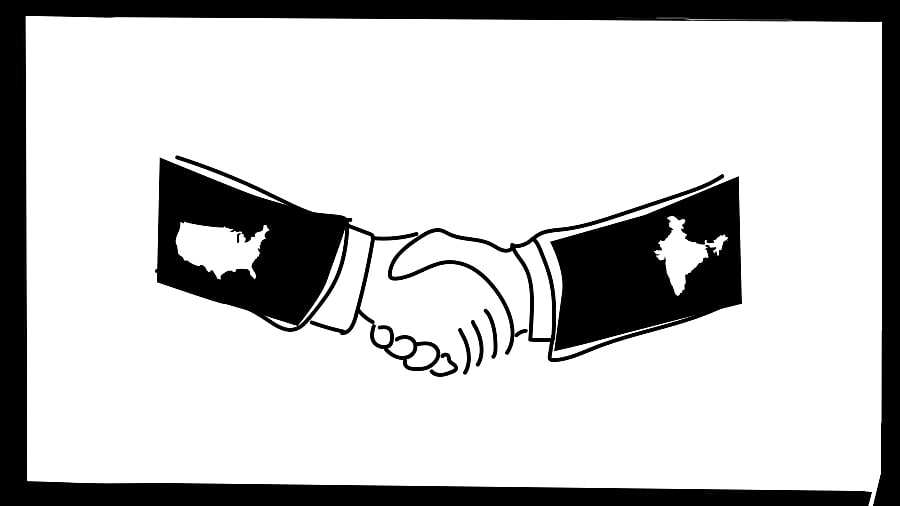
Credit: DH Illustration
President Donald Trump has a way with words. America’s federal income tax department is called the Internal Revenue Service. Trump says he will build an External Revenue Service. It is an appealing concept. Instead of burdening US taxpayers, he proposes to tax outsiders. He says America is one of the most open consumer markets with access given to all exporting countries. But those exporting countries often have high tariff walls protecting their domestic markets. He says that is unfair to America’s exporters. Hence, he has proposed to raise import tariffs to match the exporting country’s tariffs. It’s a tit-for-tat strategy, which he claims will raise much revenue for America, and punish those who keep their domestic markets protected. Never mind that the WTO rules do not allow America to selectively differentiate import tariffs for the same product from different origins. This is called the MFN rule. Never mind that raising import tariffs will hurt the American consumer, since it will raise prices and hence, inflation. Trump counters that by saying he will cut income tax, which is not feasible given the huge size of the fiscal deficit.
Never mind that the reason developing countries like India were allowed to have higher import tariffs than countries like the US was to compensate their domestic industries for domestic handicaps like high cost of power, infrastructure, credit, and lower labour productivity. This was all a part of the grand design of the World Trade Organisation (WTO) to get all on board. India and other developing countries have enjoyed special treatment for good reason, in the WTO. And yet, Trump’s threat of reciprocal punitive tariffs has an appeal to the American voter and consumer. It is also true that a country like India, boasting of being the world’s fifth-largest economy, cannot hide behind high protective tariff walls. High import tariffs do no good to foster competition, nor to Indian consumers who are denied free imports nor to inefficient industries who thrive in a protective environment.
The Trump tariff proposal gives India an opportunity to overhaul and reduce its import tariffs, at least on those items that are of interest to the US. Such a mutual agreement on tariffs will surely fall afoul of WTO’s MFN rule. But under Trump’s presidency, the WTO is getting short shrift anyway.
The Trump negotiation is a great opportunity to push tariff reform since it will be net beneficial to our export prospects and competitiveness. As such, general tariff levels have gone up since 2015 and have drifted up 4 or 5 per cent, and for non-agricultural goods, on average around 15 per cent. The time has come to slash these rates and progressively move towards a level on par with our ASEAN peers. Just as 1991 reforms were pushed through as part of conditionalities of a loan from the IMF, this tariff reform too could use an “external” justification.
Cushioning the impact
The US is India’s largest trading partner, and this fiscal, the exports to America between April and December have grown at 5.6 per cent to reach a level of $60 billion. A substantial contribution is the export of smartphones which will clock $30 billion, including exports to other countries. India has roughly a $45-billion trade surplus with the US which includes software services exports. The simple average tariff that India charges on imports, as per WTO data, is 17 per cent, whereas the US is at 3.3 per cent. But on a bilateral basis, these numbers are likely to be different. Not simple average, but a weighted average tariff difference between the two countries is likely to be about 7 or 8 per cent excluding agricultural products. A hike in import tariffs on India’s exports will hurt steel, aluminium, pharmaceuticals, and electronics. But in pharma, as with smartphones, polished diamonds, and petro products, the import component is large. So, the net negative impact is smaller.
India has agreed to increase crude oil purchases from the US which will be factored into the negotiations. By giving duty-free or moderate duty access to Harley Davidson motorcycles or Bourbon whiskey, the loss to India’s economy is negligible. But jeopardising India’s access to the software services export market of the US is a big risk. Even in this context, the big services exporters out of India to the US are American companies like EY, Accenture, IBM, Google, Microsoft, and Genpact. The proliferation of Global Capability Centres run by major American corporations in India is a tribute to the confidence in Indian talent. That trend needs to be nurtured and enhanced, and if that requires a concession by reducing import tariffs, so be it.
India could also tap into the huge untapped potential of export of agricultural products including agro-processing. At $50 billion, India’s exports are barely 1.5 per cent of global exports in agricultural and related products. India is the largest producer of milk in the world, has the highest population of cattle, is among the top two or three producers of fruits and vegetables, and has one of the longest coastlines. How well does that translate into the export of milk products, cheeses, confectionery, meat, poultry, fisheries, fruit juices, nutraceuticals, and organic foods? There is no use in hiding behind the excuse of “protecting the small farmer” for putting large export and import barriers in agricultural trade. The US can be a big exporting opportunity for this relatively neglected sector.
Thus, the Trump offer of tit-for-tat tariffs is an opportunity for India to trim its import duties and give exporters a big boost. There will be some losers, but on the balance, it can have a huge positive impact.
(The writer is an economist; Syndicate: The Billion Press)
Disclaimer: The views expressed above are the author's own. They do not necessarily reflect the views of DH.